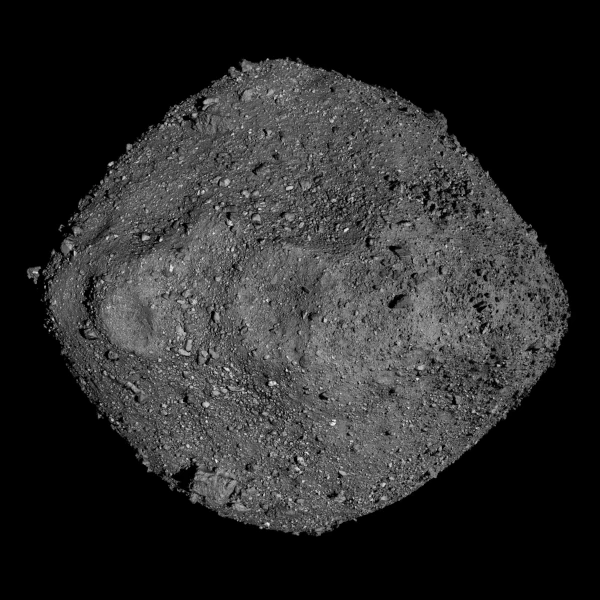
Discovered in 1999, the asteroid (101955) Bennu is an Apollo-type object measuring approximately 492 meters in diameter. Its average density of only 1.19 g/cm³ indicates that it is not a monolithic block, but an aggregate of rocks, sand, and dust held together by gravity and weak cohesive forces.
The asteroid Bennu, the target of the OSIRIS-REx mission, stunned planetary scientists by revealing a unique structure: a loose agglomerate of cosmic debris held together by weak gravitational forces. Unlike monolithic asteroids, Bennu belongs to the class of "rubble piles," where the fragments are so weakly bound that its average density \( (1.26 \pm 0.07 \, \text{g/cm}^3) \) is lower than that of coal.
Bennu's rapid rotation (one complete revolution in 4.3 hours) generates a centrifugal force equivalent to 0.0001 g at the equator, sufficient to eject particles. This phenomenon explains the "mass loss events" observed by OSIRIS-REx, where fragments of 10 cm are projected into space. Theory predicts that an asteroid of this composition should not survive a rotation speed greater than 4.1 h/rev without disintegrating.
| Parameter | Observed Value | Theoretical Prediction | Implications |
|---|---|---|---|
| Rotation Period | 4.288 h ± 0.003 | Critical limit: 4.1 h | Structure close to disintegration |
| Apparent Density | 1.19 g/cm³ | 1.5-2 g/cm³ for carbonaceous chondrites | Extreme porosity (40-60%) |
| Albedo | 0.044 ± 0.002 | 0.03-0.07 for type B asteroids | Dark surface rich in carbon |
Source: Lauretta et al., 2019 - Icarus and Nature Astronomy (2019).
In a rubble pile like Bennu, internal equilibrium results from a compromise between gravitational force and centrifugal forces related to rotation. The average gravitational stress at the surface can be estimated by \(\sigma_g \approx \rho g r\), where \(\rho\) is the average density, \(g\) is the surface acceleration, and \(r\) is the radius. For Bennu, \(g\) is on the order of \(10^{-5}\) m/s², which means that gravity there is 100,000 times weaker than on Earth.
This minuscule gravity implies that residual cohesion (Van der Waals forces between grains, possibly cementing ice) plays a significant role in stability. An increase in rotation speed beyond the internal Roche limit would cause the ejection of blocks, mainly in the equatorial region where the centrifugal force is maximal. Numerical models indicate that a period of less than 2.2 hours would make Bennu mechanically unstable.
Spectral analyses suggest that Bennu probably comes from a parent asteroid of the Polana family, itself fragmented during a collision 0.7 to 2 billion years ago. Its composition of hydrated phyllosilicates indicates that this parent body measured at least 100 km in diameter and possessed liquid water within it for several million years.
On September 24, 2023, the OSIRIS-REx sample capsule landed at 13:52 UTC in the Utah desert after a 7-year interplanetary journey. This return represents the largest asteroid sample ever brought back to Earth (estimated between 250g and 1kg), far exceeding the 5.4g brought back by Hayabusa2 from Ryugu.
The capsule, protected by a heat shield capable of withstanding atmospheric re-entry at 12 km/s, was located by radar and then recovered by a special NASA team. The controlled contamination procedures were crucial to preserve the primitive nature of the samples:
Particularly remarkable: the presence of carbon globules similar to those found in primitive meteorites, but with a much better preserved structure due to the absence of terrestrial contamination.
| Parameter | Observation | Significance |
|---|---|---|
| Texture | Extremely friable material | Confirming the "rubble pile" nature |
| Composition | Abundance of carbon (5-10% by mass) | Potential for prebiotic chemistry |
| Hydrated Minerals | Phyllosilicates detected by IR spectrometry | History of water alteration |
Source: NASA OSIRIS-REx Mission Updates and Science Magazine (2023).
The friable nature of Bennu turned the sample collection by OSIRIS-REx into a perilous operation. On October 20, 2020, the TAGSAM arm penetrated 48.8 cm below the surface - much more than the planned 5 cm - revealing a mechanical resistance lower than 0.01 MPa (100 times less than terrestrial sand). This discovery calls into question the protocols of future missions to carbonaceous asteroids.